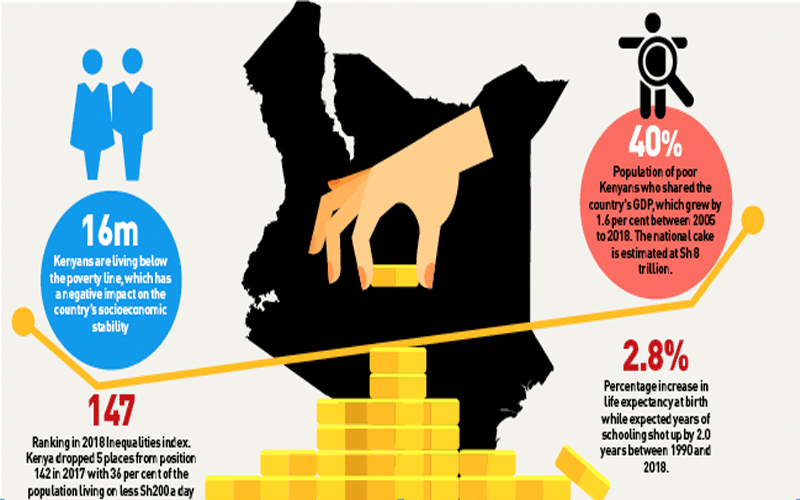16m Kenyans live on below Sh200 a day, says new UN report
By Bernard Gitau, December 18, 2019Inequality among Kenyans increased last year, with the country dropping five places from position 142 in 2017 to number 147 in 2018, according to a new report by the United Nation Development Programme (UNDP).
The 2019 Human Development Index indicates that at least 16 million Kenyans, representing a population of 34 per cent of the 47.9 million people in the country, live below the poverty line, which has a negative impact on the country’s socio-economic stability.
Inequalities, according to the report, are driven by poor policies, politics, widening gap between the poor and the rich, and emergence of new types of challenges such as access to the internet.
Though the Gross Domestic Product (GDP) has grown from Sh2 trillion in 2005 to almost Sh8 trillion in 2018, the report shows that 40 per cent of the poorest Kenyans share of the national cake grew by a measly 1.6 per cent.
Due to inequalities, the report reveals that Kenya Human Development Index (HDI) dipped by 2.2 per cent between 2010 and 2016.
Inequalities in human development hurt societies and weaken social cohesion and peoples’ trust in government, institutions and each other, the report says.
“They hurt economies, wastefully preventing people from reaching their full potential at work and in life,” reads the report.
“In Kenya in 2015, the top 10 per cent received 48 per cent of national income, while the bottom 40 per cent received nine per cent,” it adds.
Society aspirations
The report further notes that East African countries come out as being a bit less unequal, especially at the bottom compared to other countries in Africa.
This makes it harder for decisions to reflect the aspirations of the whole society as the few pulling ahead flex their power to shape decisions primarily in their interests.
Walid Badawi, the UNDP Kenya Representative, said that according to the most recent survey data that were publicly available for Kenya’s Multi-dimensional Poverty Index (MPI), 36.8 per cent of Kenyans are living below the poverty line.
This means that about 16 million Kenyans live on less than Sh200 a day.
The MPI captures the multiple deprivations that people in developing countries face in their health, education and standards of living.
“In Kenya, 36.8 per cent of the population are multi-dimensional poor while an additional 34.9 per cent classified as vulnerable to multi-dimensional poverty,” the UN official said.
According to the report, Norway is the least unequal country in the world followed by Switzerland and Ireland, while Niger, Central African Republic and Chad are the most unequal countries.
Bank deposits
Reports by the Central Bank of Kenya (CBK) indicate that only 0.7 per cent of Kenyans with bank accounts have deposits of more than Sh1 million. CBK Governor Patrick Njoroge told a parliamentary committee that 99.3 per cent of bank accounts in Kenya have deposits of less than Sh1 million.
Unemployment, gender inequality, skills mismatch, lack of access to education and health are also highlighted as the main causes of inequality in human development which starts from birth.
In health, the report shows that maternal mortality ratio is 510 deaths in every 100,000 live births.
But the Principal Secretary Department of Planning Saitoti Torome who attended the launch of the report in Nairobi yesterday said the government had reduced the maternal mortality rate, improved education attainment by women and opened political, social and economic opportunities for all.
“The report presents analysis and policy options to tackle inequalities that are the symptom of an unfair system rather than the cause,” said Torome.
Anirudh Krishna in his peer review within the report on the life stories of 35,000 households in India, Kenya, Peru, Uganda and North Carolina (United States), warns that many low-income individuals are just one illness away from poverty.
“Even relatively well-off households can drop below the poverty line after personal (such as severe health problems) or communal shocks (such as a disaster or the termination of the main source of employment),” he says in the report.
Meanwhile, Badawi said “inequalities are not about wealth alone but access to opportunities, education and health,” adding that the continent loses an estimated Sh9.5 trillion annually due to inequalities.
Between 1990 and 2018, Kenya’s life expectancy at birth increased by 8.9 years, mean years of schooling increased by 2.8 years and expected years of schooling increased by 2.0 years.
“Despite such progress there are new types of inequalities in tertiary education, access to broadband technology hence perpetuating future inequalities if they are not addressed,” Badawi added.
The report notes that a total of 29 per cent of women have some secondary education and 37 per cent for their male counterparts. Women contributed to labour force at 63.6 per cent while their male counterparts’ contribution stands at 69.1 per cent.
Badawi noted that despite Kenya ranking at position 147, income has increased by 34 per cent since 1990, which is a positive move.
“Kenya’s Gross National Income per capita increased by about 34.7 per cent between 1990 and 2018. Kenya’s 2018 Human Development Income of 0.579 is below the average of 0.634 for countries in the medium human development group and above the average of 0.541 for countries in Sub-Saharan Africa,” he said.
